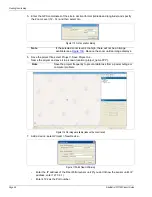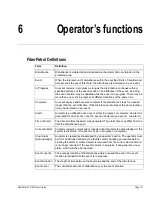
Setting Alarm Detection Parameters
Page 112
FiberPatrol FP1150 Product Guide
The first column in the Motion Rejection – Parallel panel lists the section numbers. A section is a
part of the sensor cable where Motion Rejection – Parallel can be applied to reject vibrations
caused by nearby parallel motion. Section number 0 is the first section of cable in which Motion
Rejection – Parallel has been applied. Section number 1 is the second section, etc. Any number of
sensor cable sections can be defined and each section can use different settings. The defined
sensor cable sections do not have to be contiguous. Other columns are explained below:
•
Enabled? (1 yes, 0 No):
Parallel motion rejection is applied to the section if a value of 1 is
entered in this column. A value of 0 disables the section.
•
Start and End Locations:
The length of a section is defined by entering a start location and
an end location. The values for the start and end locations use the same unit that was chosen
in the System panel (meters or feet).
•
Disturbance Magnitude:
Disturbance signals above this threshold setting are analyzed to
determine a valid parallel motion event.
•
Disturbance Time:
An object that is moving parallel to the sensor cable typically generates a
number of disturbances in a specific pattern at different locations and times. These
disturbance events are considered to be a cluster, belonging to the same parallel motion event
if the period between consecutive disturbances is less than the Disturbance Time setting. The
unit for Disturbance Time is seconds.
•
Disturbance Life:
Disturbance Life sets the time limit that a disturbance is considered to be
part of a parallel motion event cluster. Once the disturbance life expires, that disturbance does
not affect nuisance alarm rejection.
•
Delay, sec:
Delay is the time, in seconds, for which Disturbance frames are delayed before
they are analyzed to determine an alarm condition. The Delay time is used to allow for a
pattern to develop so the nuisance alarm rejection algorithm can work effectively.
•
Motion Resolution:
For a new disturbance to be part of an existing parallel motion event, its
location must be within the Motion Resolution distance from the previous disturbance.
•
Object Length:
For a cluster of disturbances to be classified as a valid moving object, the
distance traveled must be greater than the Object Length.
•
Speed:
The speed of an object, calculated from the disturbances in a cluster, must be greater
than the Speed, m/s (meters per second) setting to be rejected as a valid parallel motion
event.
Figure 129 Motion Rejection - Parallel panel






























